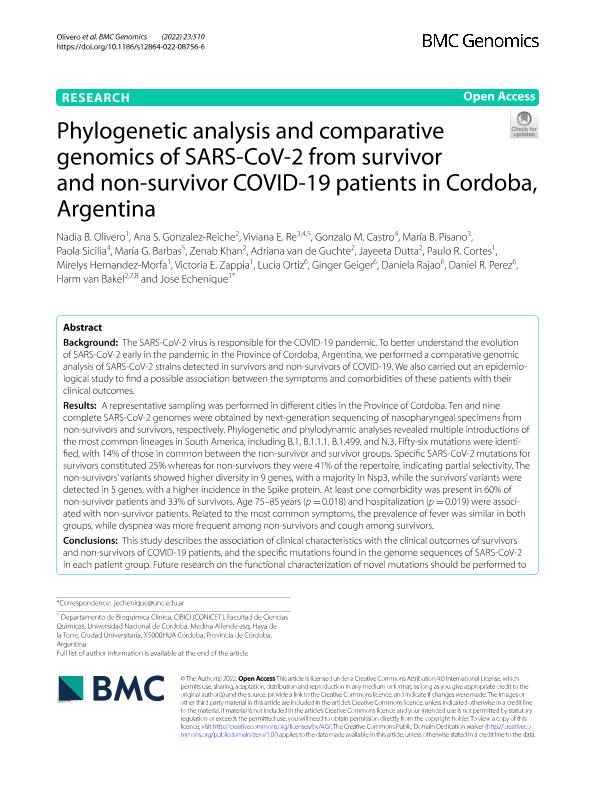Artículo
Phylogenetic analysis and comparative genomics of SARS-CoV-2 from survivor and non-survivor COVID-19 patients in Cordoba, Argentina
Olivero, Nadia Belén ; Gonzalez Reiche, Ana S.; Ré, Viviana Elizabeth
; Gonzalez Reiche, Ana S.; Ré, Viviana Elizabeth ; Castro, Gonzalo Manuel
; Castro, Gonzalo Manuel ; Pisano, María Belén
; Pisano, María Belén ; Sicilia Don, Paola Ermelinda; Barbas, María G.; Khan, Zenab; van de Guchte, Adriana; Dutta, Jayeeta; Cortes, Paulo; Hernandez Morfa, Mirelys
; Sicilia Don, Paola Ermelinda; Barbas, María G.; Khan, Zenab; van de Guchte, Adriana; Dutta, Jayeeta; Cortes, Paulo; Hernandez Morfa, Mirelys ; Zappia, Victoria Eugenia; Ortiz, Lucia; Geiger, Ginger; Rajao, Daniela; Perez, Daniel R.; van Bakel, Harm; Echenique, Jose Ricardo
; Zappia, Victoria Eugenia; Ortiz, Lucia; Geiger, Ginger; Rajao, Daniela; Perez, Daniel R.; van Bakel, Harm; Echenique, Jose Ricardo
 ; Gonzalez Reiche, Ana S.; Ré, Viviana Elizabeth
; Gonzalez Reiche, Ana S.; Ré, Viviana Elizabeth ; Castro, Gonzalo Manuel
; Castro, Gonzalo Manuel ; Pisano, María Belén
; Pisano, María Belén ; Sicilia Don, Paola Ermelinda; Barbas, María G.; Khan, Zenab; van de Guchte, Adriana; Dutta, Jayeeta; Cortes, Paulo; Hernandez Morfa, Mirelys
; Sicilia Don, Paola Ermelinda; Barbas, María G.; Khan, Zenab; van de Guchte, Adriana; Dutta, Jayeeta; Cortes, Paulo; Hernandez Morfa, Mirelys ; Zappia, Victoria Eugenia; Ortiz, Lucia; Geiger, Ginger; Rajao, Daniela; Perez, Daniel R.; van Bakel, Harm; Echenique, Jose Ricardo
; Zappia, Victoria Eugenia; Ortiz, Lucia; Geiger, Ginger; Rajao, Daniela; Perez, Daniel R.; van Bakel, Harm; Echenique, Jose Ricardo
Fecha de publicación:
12/2022
Editorial:
BioMed Central
Revista:
BMC Genomics
ISSN:
1471-2164
Idioma:
Inglés
Tipo de recurso:
Artículo publicado
Clasificación temática:
Resumen
Background: The SARS-CoV-2 virus is responsible for the COVID-19 pandemic. To better understand the evolution of SARS-CoV-2 early in the pandemic in the Province of Cordoba, Argentina, we performed a comparative genomic analysis of SARS-CoV-2 strains detected in survivors and non-survivors of COVID-19. We also carried out an epidemiological study to find a possible association between the symptoms and comorbidities of these patients with their clinical outcomes. Results: A representative sampling was performed in different cities in the Province of Cordoba. Ten and nine complete SARS-CoV-2 genomes were obtained by next-generation sequencing of nasopharyngeal specimens from non-survivors and survivors, respectively. Phylogenetic and phylodynamic analyses revealed multiple introductions of the most common lineages in South America, including B.1, B.1.1.1, B.1.499, and N.3. Fifty-six mutations were identified, with 14% of those in common between the non-survivor and survivor groups. Specific SARS-CoV-2 mutations for survivors constituted 25% whereas for non-survivors they were 41% of the repertoire, indicating partial selectivity. The non-survivors’ variants showed higher diversity in 9 genes, with a majority in Nsp3, while the survivors’ variants were detected in 5 genes, with a higher incidence in the Spike protein. At least one comorbidity was present in 60% of non-survivor patients and 33% of survivors. Age 75–85 years (p = 0.018) and hospitalization (p = 0.019) were associated with non-survivor patients. Related to the most common symptoms, the prevalence of fever was similar in both groups, while dyspnea was more frequent among non-survivors and cough among survivors. Conclusions: This study describes the association of clinical characteristics with the clinical outcomes of survivors and non-survivors of COVID-19 patients, and the specific mutations found in the genome sequences of SARS-CoV-2 in each patient group. Future research on the functional characterization of novel mutations should be performed to understand the role of these variations in SARS-CoV-2 pathogenesis and COVID-19 disease outcomes. These results add new genomic data to better understand the evolution of the SARS-CoV-2 variants that spread in Argentina during the first wave of the COVID-19 pandemic.
Archivos asociados
Licencia
Identificadores
Colecciones
Articulos(CCT - CORDOBA)
Articulos de CTRO.CIENTIFICO TECNOL.CONICET - CORDOBA
Articulos de CTRO.CIENTIFICO TECNOL.CONICET - CORDOBA
Articulos(CIBICI)
Articulos de CENTRO DE INV.EN BIOQUI.CLINICA E INMUNOLOGIA
Articulos de CENTRO DE INV.EN BIOQUI.CLINICA E INMUNOLOGIA
Citación
Olivero, Nadia Belén; Gonzalez Reiche, Ana S.; Ré, Viviana Elizabeth; Castro, Gonzalo Manuel; Pisano, María Belén; et al.; Phylogenetic analysis and comparative genomics of SARS-CoV-2 from survivor and non-survivor COVID-19 patients in Cordoba, Argentina; BioMed Central; BMC Genomics; 23; 1; 12-2022; 1-11
Compartir
Altmétricas



